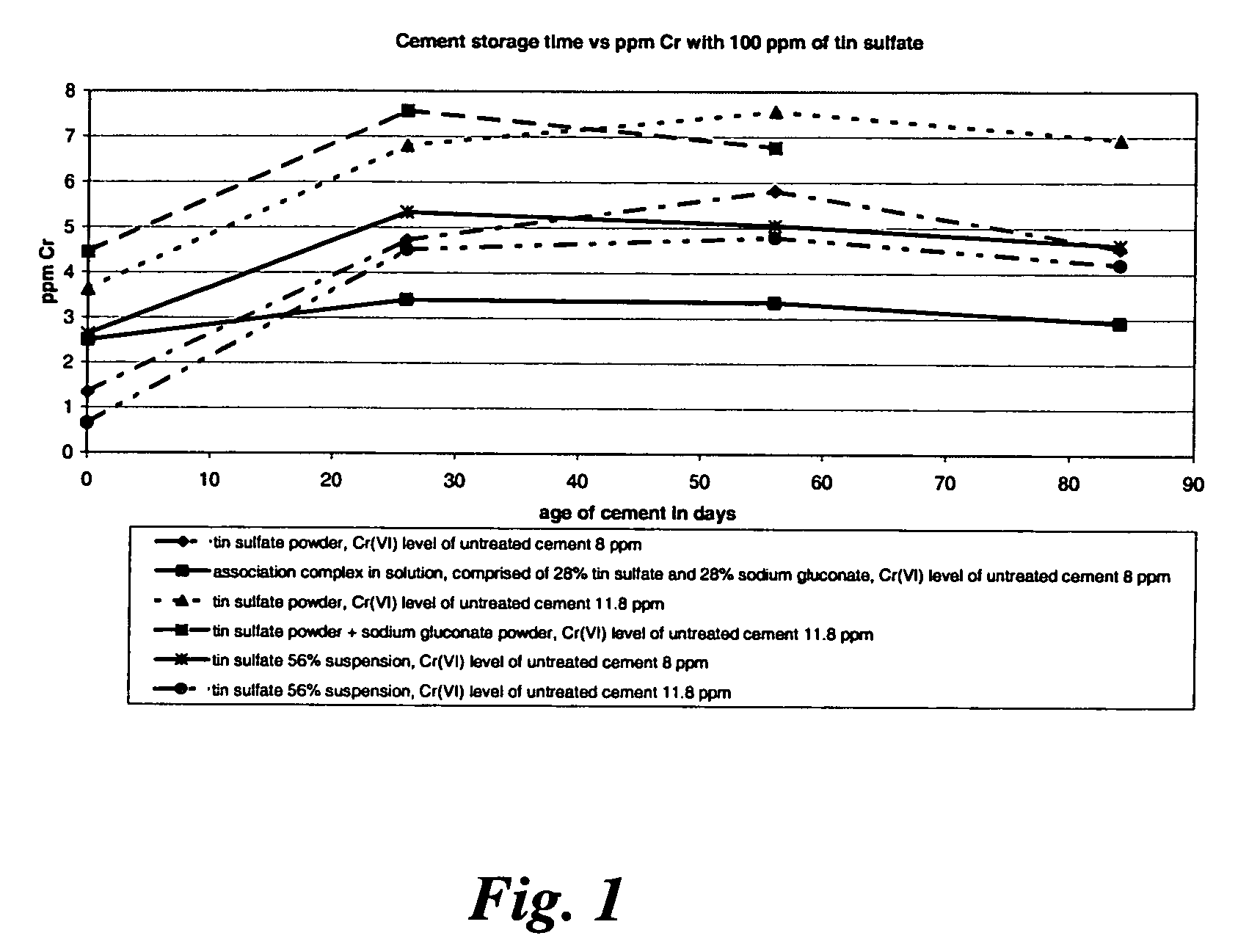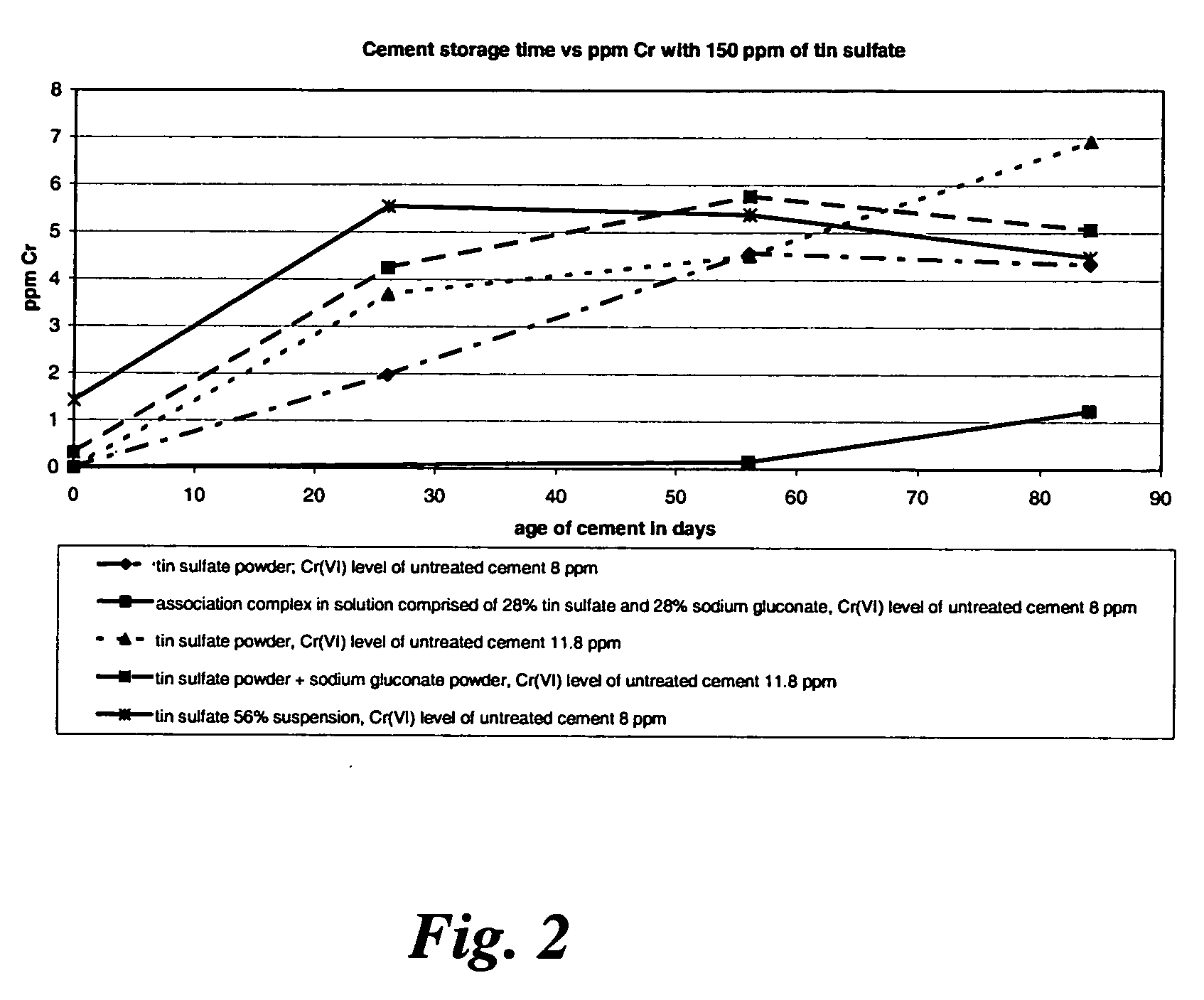Dosage efficient, storage stable compositions for reducing chromium (VI) in cement
a technology of chromium reducer and stable composition, which is applied in the field of reducing agents for hexavalent chromium (vi) in cement, can solve the problems of chromium being an unavoidable trace element, allergic reactions, eczema, and posing smaller risks, and achieves the effect of maintaining the efficacy of chromium reducer
- Summary
- Abstract
- Description
- Claims
- Application Information
AI Technical Summary
Benefits of technology
Problems solved by technology
Method used
Image
Examples
example 1
[0072] Chromium (VI) reducing agents containing stannous tin are interground into cement at dosages to insure delivery of 100 ppm of stannous sulfate to the cement. The amount of chromium in the cement may be determined by analyzing cement pore water with ultraviolet light (UV) at 375 nanometer (NM) wavelength. The cement is then stored in paper bags for various time periods, and then the chromium content is measured again.
[0073] In this case, cement was interground using a premixed stannous sulfate and sodium gluconate mixture (forming the stannous sulfate / sodium gluconate association complex of the invention in aqueous suspension), and this is compared to a case in which cement is interground with the stannous sulfate and sodium gluconate added separately in powder form (and thus not complexed). The stannous sulfate / sodium gluconate association complex had a total solids of 56% (28% stannous sulfate, 28% sodium gluconate), such that 100 parts per million (“ppm”) of stannous sulfa...
example 2
[0077] In this example, a cement is interground with premixed stannous sulfate / sodium gluconate association complex of the invention in aqueous suspension, and the chromium (VI) content of this product is compared to cement that is interground using a 56% stannous sulfate suspension (not complexed). In both cases, 100 ppm of stannous sulfate is added to cement, and in the former case (involving the association complex in aqueous suspension) 100 ppm of sodium gluconate is also delivered to the cement.
[0078] The chromium (VI) content of cement interground with the association complex was found to be reduced 8.0 ppm to 2.5 ppm, representing a decrease of 5.5 ppm. After 84 days, the chromium (VI) content was 2.9 ppm, an increase of 0.4 ppm; after 56 days, chromium content remained at 2.5 ppm; and, after 26 days, chromium content was 3.4 ppm, representing an increase of 0.9 ppm.
[0079] The chromium (VI) content of the cement interground with the tin sulfate-only suspension was found to ...
example 3
[0083] In this example, a cement that is interground with an aqueous suspension, containing the premixed stannous sulfate / sodium gluconate association complex of the invention, is compared to cement that is interground with tin sulfate powder alone (and thus not having the association complex).
[0084] In both cases, 100 ppm of tin sulfate is added to the cement, and, in the case of the premixed suspension having the association complex, 100 ppm of sodium gluconate is also delivered to the cement.
[0085] In cement interground with the stannous sulfate / sodium gluconate association complex (formed in aqueous suspension), the chromium (VI) content was reduced from 8.0 ppm to 2.5 ppm, representing a decrease of 5.5 ppm. After 84 days, the chromium content was 2.9 ppm, an increase of 0.4 ppm; after 56 days, chromium content remained at 2.5 ppm; and, after 26 days, chromium content was 3.4 ppm, representing an increase of 0.9 ppm.
[0086] In cement interground with tin sulfate powder (and n...
PUM
| Property | Measurement | Unit |
|---|---|---|
| Fraction | aaaaa | aaaaa |
| Fraction | aaaaa | aaaaa |
| Fraction | aaaaa | aaaaa |
Abstract
Description
Claims
Application Information
 Login to View More
Login to View More - R&D
- Intellectual Property
- Life Sciences
- Materials
- Tech Scout
- Unparalleled Data Quality
- Higher Quality Content
- 60% Fewer Hallucinations
Browse by: Latest US Patents, China's latest patents, Technical Efficacy Thesaurus, Application Domain, Technology Topic, Popular Technical Reports.
© 2025 PatSnap. All rights reserved.Legal|Privacy policy|Modern Slavery Act Transparency Statement|Sitemap|About US| Contact US: help@patsnap.com



